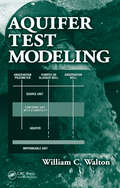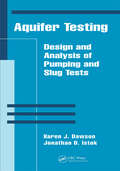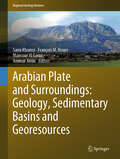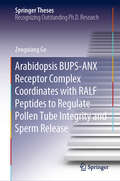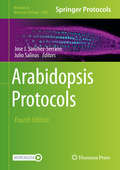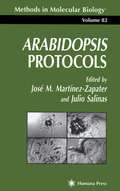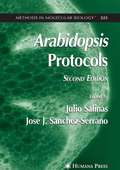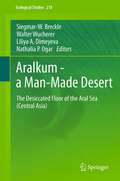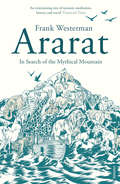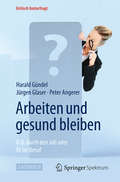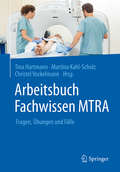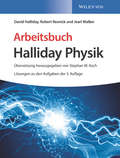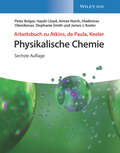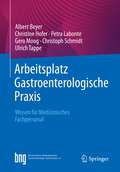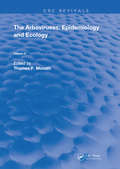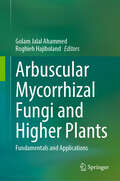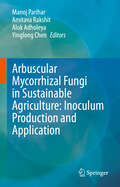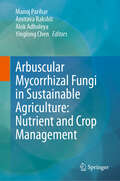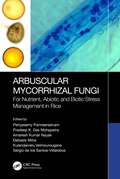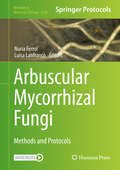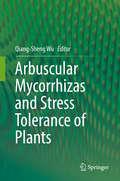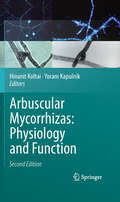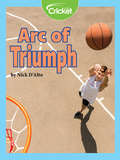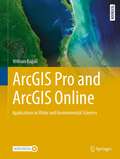- Table View
- List View
Aquifer Test Modeling
by William C. WaltonIn recognition of the trend toward using numerical methdos for analyzing aquifer test data, Aquifer Test Modeling delineates the application of numerical Laplace inversion analytical equations and numerical models and demonstrates the use of public domain software. Written by a leading expert with over fifty years of experience, this highly practic
Aquifer Testing: Design and Analysis of Pumping and Slug Tests
by Jonathan D. Istok Karen J. DawsonNew! A practical, easy-to-use reference for the design and analysis of groundwater pumping and slug testsAquifer Testing: Design and Analysis of Pumping and Slug Tests is a complete design and analysis reference emphasizing practical solutions for engineers, scientists, consultants, and students knowledgeable in basic ground water theory. T
Arabian Plate and Surroundings: Geology, Sedimentary Basins and Georesources (Regional Geology Reviews)
by Sami Khomsi François M. Roure Mansour Al Garni Ammar AminThis book focuses on the evolution of sedimentary basins of the Arabian Plate and its surroundings. Because these sedimentary basins developed in various tectonic settings, from extensional or transtensional to flexural, transpressional or compressional, their sedimentary sequences provide unique records of the regional geology. Georesources of the Arabian Plate are also described here, including petroleum potential, reservoirs, water resources, fresh water and deep saline aquifers, as well as materials and ore deposits. The book is made by a set of papers authored by geoscientists working in both academia and industry. Numerous chapters describe some regional important geologic features and selected sedimentary basins from the Middle East, North Africa and the Arabian Peninsula domains. Other chapters focus on georesources. A particular focus is given to the geology of Saudi Arabia. This book is an important contribution to the geology of the Arabian Peninsula and its surroundings. In view of the strategic and economic importance of the regional geology and georesources of the Arabian Plate and Surroundings, this volume will constitute an important reference for a wide range of geoscientists interested in the geology of this region, especially those active in petroleum geosciences and related industry. Ultimately, readers will discover important thematic maps in this book.
Arabians and Other Horses (World Book's Animals of the World)
by Karen IngebretsenIn a question and answer format the author introduces the Arabian horse and also discusses caring for a horse.
Arabidopsis BUPS-ANX Receptor Complex Coordinates with RALF Peptides to Regulate Pollen Tube Integrity and Sperm Release (Springer Theses)
by Zengxiang GeThis book summarizes the latest studies on plant reproduction and multiple aspects of signaling in reproductive development. It also presents the most advanced processes in CrRLK1L receptor and RALF peptide studies during plant development. Focusing on signaling in pollen tube integrity and sperm release regulation, it provides significant insights into the BUPS-ANX receptor complex and the corresponding ligands RALF4/19 to promote pollen tube growth with proper cell integrity. It also proposes a working model of female tissue-derived RALF34 competing with RALF4/19 from the BUPS-ANX to trigger pollen tube rupture and sperm release. Offering a detailed overview of the spatiotemporal regulation mechanism underlying the control of pollen tube integrity and sperm release, the book fills a major gap in our understanding of plant reproductive processes, and as such is a valuable resource for those working in the area of plant signaling.
Arabidopsis Protocols (Methods in Molecular Biology #2200)
by Julio Salinas Jose J. Sanchez-SerranoThis fourth edition compiles the most recent methodologies developed to exploit the Arabidopsis genome. Chapters detail access to public resources, to genetic, cell biology, biochemical and physiological techniques, and sections on genome, transcriptome, proteome, metabolome and other whole-system approaches. Written in the highly successful Methods in Molecular Biology series format, chapters include introductions to their respective topics, application details for both the expert and non-expert reader, and tips on troubleshooting and avoiding known pitfalls. Authoritative and cutting-edge, Arabidopsis Protocols, Fourth Edition aims to ensure successful results in the further study of this vital field.
Arabidopsis Protocols (Methods in Molecular Biology #82)
by Julio Salinas José M. Martínez-ZapaterInternationally recognized experts offer a comprehensive collection of significant new methods for gene mapping, cloning, and reverse genetics, as well as updated standard protocols for work with Arabidopsis genetics and molecular biology. These time-tested methods range from techniques for the successful growing of Arabidopsis to strategies for gene cloning. The sections on genetics, transformation, and gene expression analysis will be especially helpful to scientists involved in mutant analysis or in producing and analyzing transgenic plants. In many cases, the protocols can also be applied to other plant species, with minor adjustments. Serving both experienced researchers and beginners in the field, Arabidopsis Protocols will immediately become the standard reference for laboratories working with Arabidopsis, the plant of choice to approach many fundamental questions in plant biology.
Arabidopsis Protocols, 2nd Edition (Methods in Molecular Biology #323)
by Julio Salinas Jose J. Sanchez-SerranoThis collection of readily reproducible Arabidopsis protocols has been updated to reflect recent advances in plant biology, the completion of the Arabidopsis genome sequence, which is essential for studying plant function, and the development of whole systems approaches that allow global analysis of gene expression and protein and metabolite dynamics. The authors have included nearly all techniques developed in Arabidopsis, others recently adapted from the traditional work in crop species, and the most recent ones using Arabidopsis as a model system. Highlights include the most recent methods-transcriptomics, proteomics, and metabolomics - and their novel applications (phosphoproteomics, DNA microarray-based genotyping, high throughput metabolite profiling, and single-cell RNA).
Aralkum - a Man-Made Desert: The Desiccated Floor of the Aral Sea (Central Asia) (Ecological Studies #218)
by Siegmar-W. Breckle Liliya A. Dimeyeva Nathalia P. Ogar Walter WuchererHaving been the fourth largest lake on the globe roughly 50 years ago, today the Aral Sea no longer exists. Human activities caused its desiccation and the formation of a huge new desert, the Aralkum, which can be regarded as one of the greatest ecological catastrophes and - at the same time - the largest primary succession experiment of mankind. This volume brings together the results of international and interdisciplinary long-term studies on the new desert ecosystem and is divided into four main sections. The first section provides an overview of the physical characteristics of the area and covers geological, pedological, geomorphological and climatological aspects and their dynamics, especially dust-storm dynamics. The second focuses on the biotic aspects and highlights the spatial and temporal patterns of the flora and fauna. In the third section studies and projects aiming to combat desertification by phytomelioration and to develop strategies for the conservation of biodiversity are presented. The book is rounded off with a section providing a synthesis and conclusions.
Ararat: In Search of the Mythical Mountain
by Frank WestermanMount Ararat in Turkey is where, as biblical tradition has it, Noah's Ark ran aground and God made his covenant with mankind. Now it stands astride the fault-line between religion and science, a geographical, political and cultural crossroads, bound up with the centuries-old history of warfare between different cultures in this region. Frank Westerman takes a pilgrimage from the mountain's foot to its highest slopes, meeting along the way geologists, priests and an expedition in search of the Ark's remains, as well as a Russian astronaut who observes that 'there is something between heaven and earth about which we humans know nothing'. Ararat is a dazzling, highly personal book about science, religion and all that lies between, by one of Europe's most celebrated young writers.
Arbeiten und gesund bleiben: K.O. durch den Job oder fit im Beruf (Kritisch hinterfragt)
by Harald Gündel Jürgen Glaser Peter AngererWann hält uns Arbeit gesund und wann macht sie uns krank? Wissenschaftlich fundiert, humorvoll und anschaulich werden in diesem Werk Themen wie Arbeitsfreude und Kreativität, positive und negative Seiten der Teamarbeit, Führungskräfte als Antreiber oder Unterstützer, Wandel oder Stabilität im Betrieb, Zeitdruck und psychischer Stress versus Erholung und Freizeit, Burnout, und auch Arbeitsplatzverlust hinterfragt und dargestellt. Alle Themen werden im Hinblick auf gesunderhaltende und krankmachende Faktoren aus psychologischer und medizinischer Sicht beschrieben und mit wissenschaftlichen Befunden anschaulich belegt. Daraus werden Empfehlungen auf individueller, betrieblicher und gesellschaftlicher Ebene abgeleitet und begründet. Das Buch richtet sich vor allem an interessierte Laien, die sich die Frage stellen, wie sich engagiertes Arbeiten und eine gute (biologische, psychologische und soziale) Gesundheit miteinander vereinbaren lassen. Weitere Zielgruppen sind Unternehmensleitungen, Fach- und Führungskräfte, Arbeitnehmervertreter, Betriebsärzte, Arbeitspsychologen, Hausärzte und weitere Fachleute, die das Thema der Gefährdungsbeurteilung "Psychische Belastung" betrifft und alle, für die es zunehmend wichtiger wird, Zusammenhänge zwischen Arbeit und Gesundheit besser zu verstehen. Autoren: Peter Angerer ist Kardiologe und Arbeitsmediziner und leitet das Institut für Arbeitsmedizin und Sozialmedizin an der Universität Düsseldorf. Jürgen Glase r ist Arbeits- und Organisationspsychologe und Professor für Angewandte Psychologie an der Universität Innsbruck. Harald Gündel ist Psychosomatiker und leitet die Klinik für Psychosomatische Medizin und Psychotherapie am Universitätsklinikum Ulm.
Arbeitsbuch Fachwissen MTRA: Fragen, Übungen und Fälle
by Tina Hartmann Martina Kahl-Scholz Christel VockelmannFragen, Übungen und Fälle zum Lernen! Dieses Buch ist das ideale Begleit- und Übungsbuch zum Lehrbuch ,,Fachwissen MTRA", kann aber auch für sich stehend als Übungsbuch zur Vertiefung des MTRA-Wissens benutzt werden. Es hilft, das Gelernte zu vertiefen und durch Fallbeispiele in die Praxis zu übertragen. Nach Fällen gegliedert, werden reale Situationen beschrieben, mit Fragen und Lösungen dargestellt sowie mit zahlreichen Abbildungen versehen. An vielen Stellen kann der Leser selbst mit dem Buch interagieren, etwa bei der Beschriftung anatomischer oder radiologischer Abbildungen. Das leserfreundliche Layout mit Randspalte erlaubt zudem, eigene Notizen und Antwortmöglichkeiten ins Buch zu schreiben. Viele Kapitel und Themen, die in der MTRA-Ausbildung und dem MTRA-Arbeitsalltag zentral sind, werden hier erneut aufgegriffen und in Fallbeispielen beleuchtet: Anatomie Besonderheiten in der Pädiatrie Computertomographie Durchleuchtung Kernspintomographie Kontrastmittel Konventionelle Röntgendiagnostik Nuklearmedizin Patient im Krankenhaus Qualitätssicherung/-management RIS/PACS inkl. Datenschutz Sonographie Strahlenschutz Strahlentherapie Wissenschaftliches Arbeiten
Arbeitsbuch Halliday Physik, Lösungen zu den Aufgaben der 3. Auflage
by David Halliday Robert Resnick Jearl Walker Stephan W. Koch Matthias Delbrück Michael BärDas Arbeitsbuch zur dritten Auflage des "Halliday" hilft bei der Durchdringung des Stoffs der einfuhrenden Experimentalphysik-Vorlesungen fur Hauptfachstudierende. Es enthalt die Losungen inklusive des Losungswegs zu mehr als 2500 Aufgaben unterschiedlichen Schwierigkeitsgrades aus allen Kapiteln des Lehrbuchs. Die Aufgaben stammen aus allen Themenbereichen der Experimentalphysik und reichen von Standardaufgaben, die jeder konnen muss, bis hin zu weiterfuhrenden Aufgaben fur Fortgeschrittene. Sowohl einzeln erhaltlich als auch im Deluxe-Set mit dem Lehrbuch!
Arbeitsbuch zu Atkins, de Paula, Keeler Physikalische Chemie
by Stephanie Smith James J. Keeler Peter Bolgar Haydn Lloyd Aimee North Vladimiras OleinikovasDas Arbeitsbuch zum neuen "großen Atkins"! Der "große Atkins" ist und bleibt ein Muss für alle Studierenden, die sich ernsthaft mit der Physikalischen Chemie auseinandersetzen. In unverwechselbarem Stil deckt Peter Atkins mit seinen Koautoren Julio de Paula und James Keeler die gesamte Bandbreite dieses faszinierenden und herausfordernden Fachs ab. Das darauf abgestimmte Arbeitsbuch bietet die vollständigen Lösungen der leichteren "a"-Aufgaben und der schwereren Aufgaben sowie Musterantworten zu den ungeraden Diskussionsfragen.
Arbeitsplatz Gastroenterologische Praxis: Wissen für Medizinisches Fachpersonal
by Christoph Schmidt Albert Beyer Christine Hofer Petra Labonte Gero Moog Ulrich TappePraxisbuch für Medizinisches Fachpersonal in einer gastroenterologischen Schwerpunktpraxis Da der Bereich Gastroenterologie in der Ausbildung nur gestreift wird, müssen Medizinische Fachangestellte und Gesundheits- und Krankenpflegerinnen, die in einer gastroenterologischen Praxis oder Klinik arbeiten möchten, ihr Wissen durch "learning by doing" und mit Hilfe von Weiterbildungen erwerben. In diesem Buch profitieren Praxismitarbeiterinnen vom Erfahrungsschatz des renommierten Autorenteams und gewinnen schnell die gewünschte Sicherheit am "Arbeitsplatz in der gastroenterologischen Praxis“. Ob Darmkrebsvorsorge, Endoskopie oder Abrechnung – die Autoren vermitteln das Wissen, das Medizinisches Fachpersonal für die Arbeit in der gastroenterologischen Praxis oder Klinik benötigen. Verständlich fasst es die wichtigsten Krankheitsbilder aus dem Fachbereich zusammen und erläutert medizinische Zusammenhänge. Es werden alltägliche Untersuchungsmethoden von der Endoskopie über den Ultraschall bis hin zum Atemtest erklärt. Ein weiteres Kapitel widmet sich den gastroenterologischen Notfällen. Aber auch viele Praxistipps für die Aufbereitung von Medizinprodukten, zur Hygiene sowie zur Abrechnung erhalten die PraxismitarbeiterInnen in diesem Buch.Ein praxisnahes, kompaktes Buch – verständlich für Medizinisches Fachpersonal geschrieben.
Arboviruses: Epidemiology and Ecology (Routledge Revivals #3)
by Thomas P. MonathFirst Published in 1988, this five volume set documents the transmission and growth of Arthropod born viruses. Carefully compiled and filled with a vast repertoire of notes, diagrams, and references this book serves as a useful reference for Students of Epidemiology, and other practitioners in their respective fields.
Arbuscular Mycorrhizal Fungi and Higher Plants: Fundamentals and Applications
by Golam Jalal Ahammed Roghieh HajibolandThis book covers the fundamentals of arbuscular mycorrhizal fungi (AMF) and higher plant symbiosis with potential implications in crop production. It provides new insights into our understanding of the mechanisms of AMF-mediated plant growth regulation and stress tolerance covering the most recent biochemical, physiological, molecular, environmental, and ecological studies. Focusing on AMF-induced physiological and molecular mechanisms of enhanced tolerance to stress, environmental stress is discussed in several dedicated chapters. The book provides not only updated information with new insights and perspectives but also several new topics, such as a comprehensive discussion on biotic stressors, AMF interaction with other microorganisms, non-host plant species, plant secondary metabolism, signaling events in plant-AMF symbiosis, AMF-mediated nutrient acquisition and subsequent stress tolerance. The book also discusses the potential implications of AMF for sustainable crop production in the context of climate change. The book can be a useful reference book for academics and scientists involved in related research, such as academics in agronomy and plant sciences, scientists involved in beneficial fungi research, chemists, industrialists, and employees involved in the production and marketing of biofertilizers, master and doctoral degree students of agronomy, horticulture, and plant protection, consultants working on the production of crops in marginal environments as well as environmental scientists working for assisted phytoremediation programs. It would also be suitable for agronomy, ecology, and plant science-related courses, such as plant stress physiology, plant growth-promoting microbes, and plant pathology to teach undergraduate, graduate, and postgraduate students at colleges and universities.
Arbuscular Mycorrhizal Fungi in Sustainable Agriculture: Inoculum Production and Application
by Amitava Rakshit Manoj Parihar Alok Adholeya Yinglong ChenThis 2-volume book is an up-to-date overview of current progress in Arbuscular Mycorrhizal Fungal (AMF) technique development, inoculum production and its quality regulations, application in agriculture, horticulture, agroforestry, and other ecosystems, along with nutrient management for sustainable food production. It contains the current advancement in basic and molecular techniques, challenges, opportunities, and determinates of various AMF production methods and major tools and techniques for their field application. Production and development of AMF is rapidly evolving and requires a multidisciplinary approach with up-to-date knowledge to broaden and strengthen the perspective of researchers involved in this domain. The volumes offer new insight and cutting-edge information for novices and experts such as students, academicians, researchers, environmentalists, industrialists, and others interested in mycorrhiza. The first volume covers some basic isolation techniques, enumeration,and molecular studies with recent advances in various in-vitro and in-vivo production technologies, regulatory issues, and application methodologies for field inoculation. It also discusses AMF application in various agroecosystems for sustainable agricultural production and a healthier planet.
Arbuscular Mycorrhizal Fungi in Sustainable Agriculture: Nutrient and Crop Management
by Amitava Rakshit Manoj Parihar Alok Adholeya Yinglong ChenThis 2 volume book is an up-to-date overview of current progress in Arbuscular Mycorrhizal Fungal (AMF) technique development, inoculum production and its quality regulations, application in agriculture, horticulture, agroforestry and other ecosystems along with nutrient management for sustainable food production. It offers new insight and cutting-edge information for novices and experts such as students, academicians, researchers, environmentalists, industrialists, and other individuals interested in the field of mycorrhiza.AMF provides favorable rhizospheric environment to the plant with numerous direct and indirect mechanisms, in exchange of soil nutrients and photosynthetically fixed carbon. Other than the species composition and diversity determination of natural ecosystem, AMF play a vital role in maintaining the soil quality, agricultural sustainability and environmental integrity. The second volume provide comprehensive knowledge on AMF role in nutrient cycling, nutrient exchange and their acquisition under normal and stress condition.
Arbuscular Mycorrhizal Fungi: For Nutrient, Abiotic and Biotic Stress Management in Rice
by Periyasamy PanneerselvamArbuscular mycorrhizal fungi (AMF) are considered enormously important in contemporary agriculture and horticulture due to their important role in nutrient, biotic and abiotic stress management apart from enhancing plant health and soil fertility. AMF is one of the important fungi for soil aggregation, which helps in drought management. Hence this book brings out an exclusive text on AMF for sustainable rice production. It provides comprehensive up-to-date knowledge on AMF in rice cultivation, and for sustainable rice production in different ecologies without damaging the environment. Salient Features: 1. Covers all the aspects of AMF in rice cultivation from diversity to applications 2. Documents AMF diversity based on metagenomic approach in rice ecosystems 3. Explains the importance of AMF in soil aggregation, which helps in drought management 4. Provides new unraveling knowledge about AMF for sustainable rice production in different ecologies without damaging the environment 5. Discusses the AMF role in induction of resistance in rice plants against some pests.
Arbuscular Mycorrhizal Fungi: Methods and Protocols (Methods in Molecular Biology #2146)
by Nuria Ferrol Luisa LanfrancoThis book compiles the most comprehensive collection of protocols currently used in arbuscular mycorrhizal (AM) fungal research. This experience-based collection includes methods for isolation, cultivation, detection, and quantification of AM fungi, as well as the use of metagenomics for community studies and experimental procedures for functional genomics. Written for the highly successful Methods in Molecular Biology series, chapters include introductions to their respective topics, lists of the necessary materials and reagents, step-by-step, readily reproducible laboratory protocols, and tips on troubleshooting and avoiding known pitfalls. Authoritative and cutting-edge, Arbuscular Mycorrhizal Fungi: Methods and Protocols serves as an ideal aid for researchers seeking to perform experiments that fill the gaps in our knowledge of the basic biology, functions, and ecology of AM fungi in the hope of deploying these powerful plant fungal symbionts in agriculture more effectively.
Arbuscular Mycorrhizas and Stress Tolerance of Plants
by Qiang-Sheng WuThis book reviews the potential mechanisms in arbuscular mycorrhizas (AMs), in the hope that this can help arbuscular mycorrhizal fungi (AMF) to be more used efficiently as a biostimulant to enhance stress tolerance in the host plants. AMF, as well as plants, are often exposed to all or many of the abiotic and biotic stresses, including extreme temperatures, pH, drought, water-logging, toxic metals and soil pathogens. Studies have indicated a quick response to these stresses involving several mechanisms, such as root morphological modification, reactive oxygen species change, osmotic adjustment, direct absorption of water by extraradical hyphae, up-regulated expression of relevant stressed genes, glomalin-related soil protein release, etc. The underlying complex, multi-dimensional strategy is involved in morphological, physiological, biochemical, and molecular processes. The AMF responses are often associated with homeostatic regulation of the internal and external environment, and are therefore critical for plant health, survival and restoration in native ecosystems and good soil structure.
Arbuscular Mycorrhizas: Physiology And Function
by Hinanit Koltai Yoram KapulnikIn the years since the first edition of "Arbuscular Mycorrhizas: Physiology and Function" was published, an exceptional proliferation of interest in mycorrhizal biology has developed. This has been associated with advances in different research disciplines such as genetics, genomics, proteomics, metabolomics and physiology, advances which have generated better insight into topics of mycorrhizal biology, including the mechanisms of host-mycorrhiza interactions pre- and post-penetration, the influence of the symbiosis on the host and its surroundings, and the evolution and diversity of mycorrhization. It therefore became necessary to both update and expand the book's coverage in this, its second edition.
Arc of Triumph
by Nick D'AltoEver wonder why sports balls always seem to move in an arc when thrown or hit? Explore the physics of parabolic motion through the use of basketballs, tennis balls, and baseballs. Once you've figured out how the kinetic energy of a thrown ball is replaced by potential energy, you can use these facts to help you play sports in real life!
ArcGIS Pro and ArcGIS Online: Applications in Water and Environmental Sciences (Springer Textbooks in Earth Sciences, Geography and Environment)
by William BajjaliThis textbook serves as a practical guide for undergraduate and graduate students in geology, hydrology, ecology, and environmental sciences, teaching them applied GIS techniques. Presented as a step-by-step tutorial across seventeen chapters, the book starts with the fundamentals of GIS and progresses to real-life examples from geology and water resources. The focus is on ESRI's ArcGIS Pro, covering various tools for spatial, geostatistical, network, and 3-D analysis. Additionally, it explores ArcGIS Online and working with web apps like Web Map, StoryMaps, and GEO App.GIS applications, especially in water and environmental problem-solving, are rapidly growing worldwide. The demand for GIS experts utilizing spatial analysis in environmental science remains high. This textbook equips users with the necessary knowledge to become effective mappers and spatial analysts in the fields of environment, geosciences, and water resources, employing the latest state-of-the-art methodology.Each chapter provides exercises and supplementary materials available for download on SpringerLink, along with additional links for further learning opportunities.
